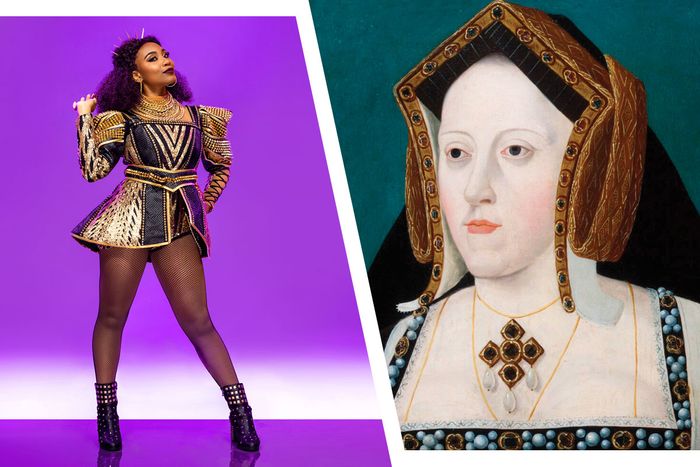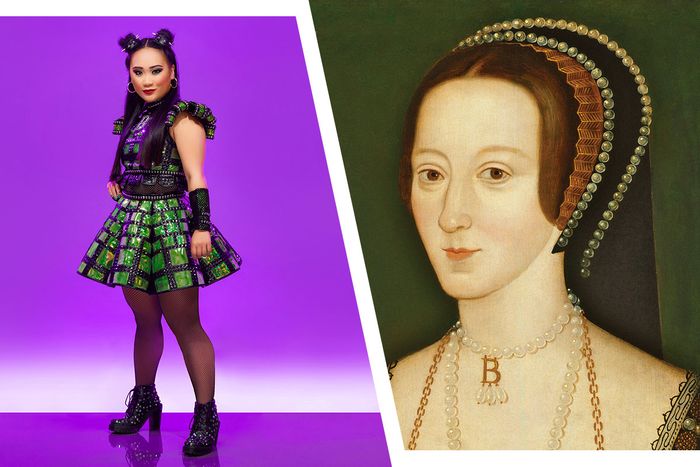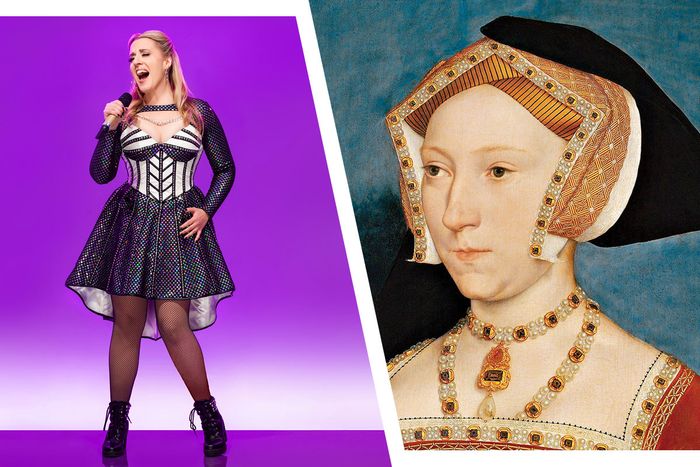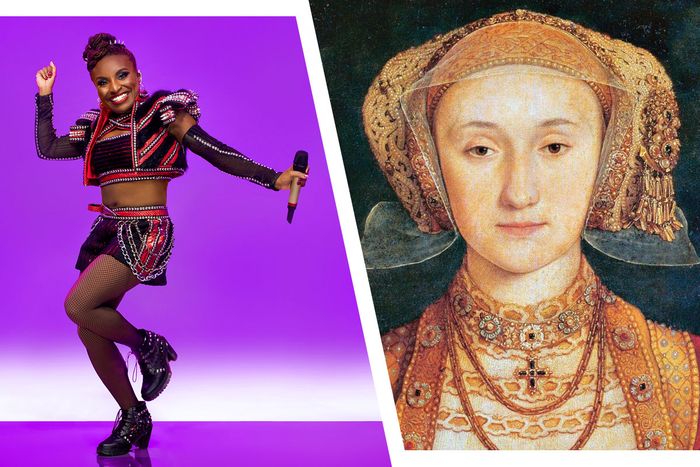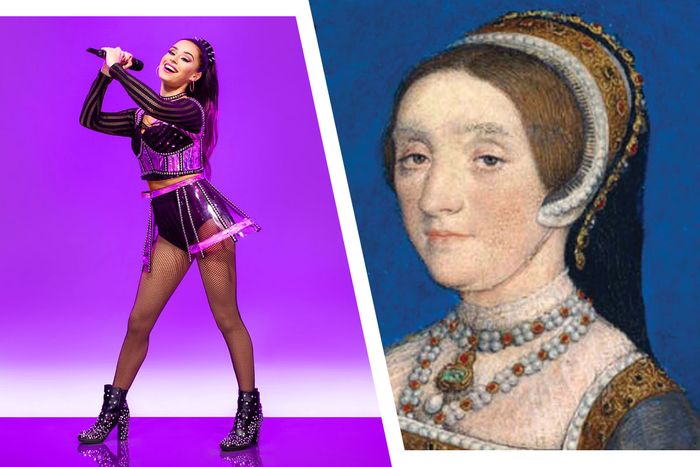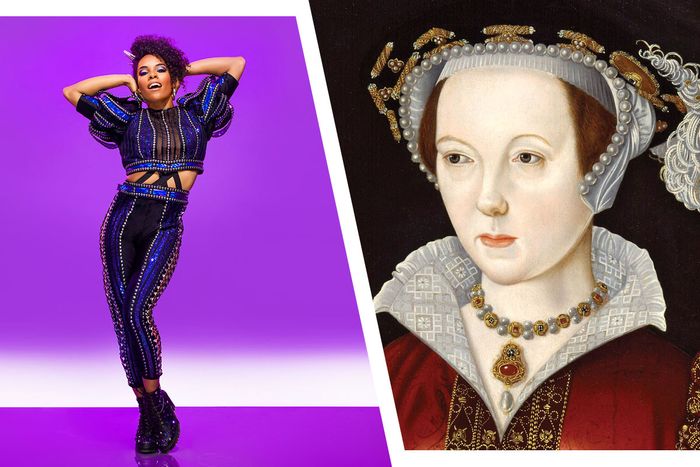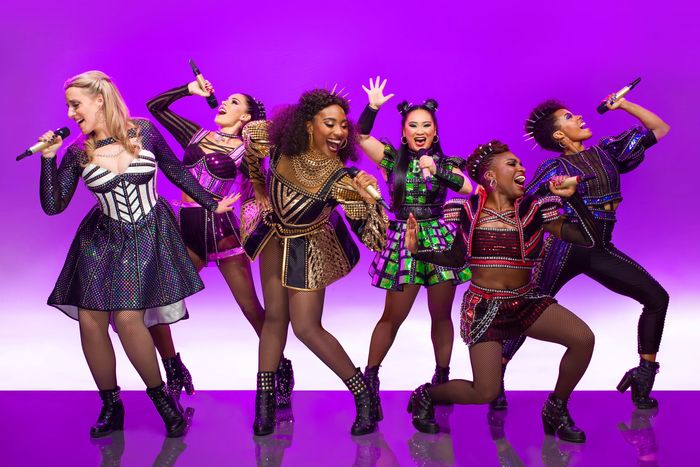
What if, after all the divorces (or, technically, annulments), beheadings, and deaths, Henry VIII’s six wives got together in a kind of 16th-century version of VH1’s Divas Afterlife? That’s the concept behind Six, a musical that imagines all the wives in a singing competition — with six solos, three group numbers, and, of course, one megamix — about who had the worst go of it. Six was created in 2017 by Toby Marlow and Lucy Moss when they were Cambridge undergrads. They were always worried about the possibility that Six could be “terrible” given its audacious concept. But, says Marlow, “Lucy was like, ‘Maybe a way of not making it terrible is to give the show a sense of humor.’ ” And it’s definitely not terrible: It has already traveled to London’s West End, Chicago, Boston, Edmonton, Sydney, and several cruise ships. Now, it’s finally on Broadway. How exactly did history and diva worship coalesce into one remarkable show? Marlow, Moss, and the American cast walked us through the creation of the six queens of Six.
1. Catherine of Aragon
Married 1509–33
Played by Adrianna Hicks
IRL: Daughter of King Ferdinand and Queen Isabella of Spain and widow of Henry’s brother, Arthur. Her only child to survive was Mary (later, “Bloody Mary”). He tried to dump her for Anne Boleyn, using her previous marriage to his brother as an excuse. But the pope wouldn’t grant him an annulment. So Henry invented the Church of England in order to get one.
As a diva: In Hicks’s interpretation, Catherine is a combination of J.Lo, Jennifer Hudson, and Lemonade-era Beyoncé.
Her song: “No Way,” an up-tempo kiss-off number. “The first song has to be what the audience expects: ‘Sit down, shut up, I’m an independent woman,’ ” Moss says. “Before you then do interesting stuff.” (Note: We’ve embedded links to the London cast recording for your reference and enjoyment.)
Standout lyric: “You say it’s a pity, ’cause quoting Leviticus, I’ll end up kiddiless all my life,” goes Moss and Marlow’s neat paraphrase of Henry’s justification for annulment.
Anne Boleyn
Married 1533–36
Played by Andrea Macasaet
IRL: Henry had a crush on Anne, who was one of the queen’s ladies-in-waiting, but she insisted he put a ring on it. Even after he invented an entirely new church, still no male heirs. Their only surviving child became Queen Elizabeth I. In the end, Henry cooked up a pretext to have Anne beheaded so he could move on. She was often described as a seductress who flirted her way to the throne, so Moss wanted “to take the piss out of that kind of historian” by having Anne accidentally create chaos and respond to it with “LOL, my bad.”
As a diva: Lily Allen meets Avril Lavigne meets all five Spice Girls.
Her song: “Don’t Lose Ur Head,” a rude, punky patter number. With over 18 million listens on Spotify, it’s the musical’s most popular. Fans often show up dressed as Anne, with a “Greensleeves”-green dress and spiky buns. “These young adults take the time to make their own costumes and show up to the show and patiently wait for me to make eye contact with them,” Macasaet said.
Standout lyric: Anne responds to Henry’s excommunication with “Everybody chill, it’s totes God’s will.”
3. Jane Seymour
Married 1536–37
Played by Abby Mueller
IRL: Days after Anne lost her head, Henry married another lady-in-waiting, Jane. She died shortly after giving birth to Henry’s son, Edward VI. (She and Henry would eventually be buried next to each other.)
As a diva: The mononymous pop balladeers Céline, Adele, Sia, and the more wistful side of Rihanna. “Rihanna should do a cover!,” Marlow jokes. “Make it happen.”
Her song: “Heart of Stone,” a crescendoing series of vocal acrobatics built around her devotion to Henry. “The idea was about the strength of choosing to love someone and committing to someone,” Moss says, “and that being an equally valid feminist experience.”
The Tone: Without a great deal of historical information about Jane, Marlow and Moss gave the character what Mueller knowingly calls dorky “mom jokes.” “The historical stereotype is that she’s the boring one,” she says. “I love that she gets to say, ‘I wasn’t stupid, I wasn’t naïve.’ ”
Anne of Cleves
Married 1540
Played by Brittney Mack
IRL: Next up: a strategic political marriage to one of the sisters of Germany’s Duke of Cleves. Most famous for being rejected by Henry for not looking as good as her portrait (or so he claimed). Six months in, she accepted an annulment and a generous settlement. The show calls her Anna of Cleves.
As a diva: The “Feeling Myself” vibe of Nicki Minaj and Beyoncé, plus the wealth parody of Iggy Azalea and Charli XCX’s “Fancy” and Lorde’s “Royals.”
Her song: “Get Down,” in which Marlow and Moss reframe contemporary odes to opulence with brags about “pheasant instead of Grey Goose,” as Moss says. “When you hear ‘Get Down,’ immediately you want to get into this ‘urban’ approach to her,” Mack says. “But as a black woman portraying this role, I don’t want to do that.” Mack cites the poise of Janet Jackson and Tina Turner as inspiration for her performance but notes that “it’s so wonderful that” in every production of Six, the character is not always played by a black actor.
Standout Lyric: “Okay, ladies, let’s get in Reformation.”
Catherine Howard
Married 1540–42
Played by Samantha Pauly
IRL: Henry became smitten by another of the queen’s ladies-in-waiting. They lasted a year or so, but then he had her beheaded for treason on the basis of adultery. Moss and Marlow conceived of her as the survivor of sexual abuse. The show spells her first name with a K.
As a diva: An amalgam of “young pop stars sexualized early on in their careers,” as Marlow puts it, like Miley Cyrus, Britney Spears, and Ariana Grande (the inspiration for the queen’s ponytail).
Her song: “All You Wanna Do,” in which Moss and Marlow use the earwormy hooks of a repeated chorus to emphasize the repetitive nature of the abuse she experienced.
The tone: The dark core of the bubblegum-packaged song isn’t necessarily apparent out of context. So the actress playing her has to bring out both sides of the music and lyrics. “I have to stay in this pop-show mode,” Pauly says. “But I also have to make it clear things aren’t what they seem. It isn’t until the end of the song that people are like, ‘I’ve been laughing the whole time; maybe I shouldn’t.’ ”
Catherine Parr
Married 1543–47
Played by Anna Uzele
IRL: The one who outlived him, marrying Henry after having several relationships of her own (she was a widow). Catherine pushed for women to be able to study the Bible unsupervised by men (a big step for the time). She got his daughters Mary and Elizabeth restored to the order of succession and acted as regent when Henry went to war with France. She survived him by a year and a half.
As a diva: Emeli Sandé, Alicia Keys, and “the side of Beyoncé when she’s talking to the audience as if she’s their best friend,” according to Moss. “There’s one point where I feel like I should pop a squat at the edge of the stage, maybe even play the piano myself,” Uzele says. “We’re not going to do those actual things, but that’s the vibe we’re going for.”
Her song: “I Don’t Need Your Love,” a jazzy solo that starts as a letter to the man Catherine had to abandon for Henry and morphs into a group number directed at the king.
The Tone: In a show of tricky tonal shifts, Six’s transition from the devastation at the end of “All You Wanna Do” to the rousing, girl-power spirit of “I Don’t Need Your Love” might be the hardest to pull off without seeming glib.
*This article appears in the March 2, 2020, issue of New York Magazine. Subscribe Now!



